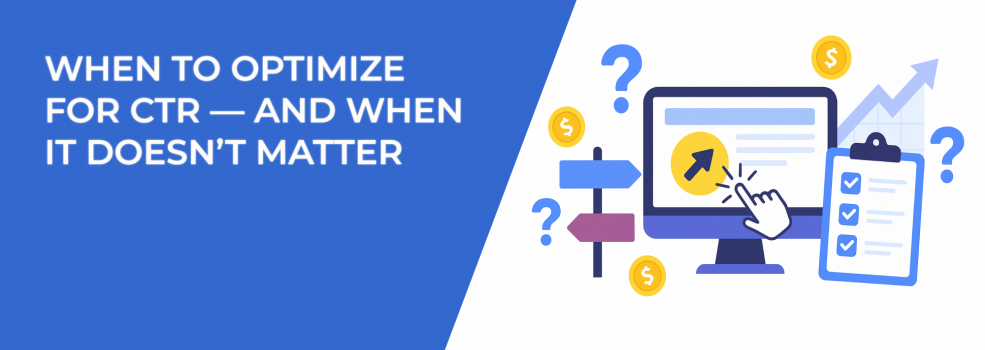Click-through rate (CTR) often feels like a shiny number every advertiser wants to improve. After all, more clicks usually suggest your ad is working. But here’s the truth: CTR can be a very helpful metric in some cases, and almost irrelevant in others.
The key is knowing the difference. Should you chase higher CTRs at all costs, or sometimes let them slide? Let’s walk through the situations where CTR deserves your attention — and when it’s better to focus on other performance numbers.
What CTR Really Tells You
CTR (click-through rate) measures the percentage of people who click on your ad after seeing it. A high CTR usually means your creative stands out and grabs attention — the headline, image, or offer resonates.
But CTR only shows attention, not intention. People might click out of curiosity without any plan to buy. That’s why CTR alone can be misleading.
Here’s what CTR can and can’t tell you:
-
What it tells you:
-
If your ad captures attention.
-
How well it resonates with your audience.
-
How you compare to industry benchmarks.
-
-
What it doesn’t tell you:
-
Whether clicks become leads or sales.
-
If the campaign is profitable.
-
The real value of those clicks.
-
Think of CTR as an engagement signal, not a success metric. To know if an ad is truly working, you need to pair CTR with conversion and cost data.
If you’ve struggled with good CTR but weak results, you’ll find our guide on How to Analyze Facebook Ad Performance Beyond CTR and CPC especially useful.
When You Should Optimize for CTR
There are several clear cases where CTR is worth tracking closely and improving:
1. When You’re Testing New Ads
Early in a campaign, CTR acts like a fast feedback loop. Instead of waiting weeks for conversion data to pile up, you can see within days which ad versions capture attention.
-
If Ad A gets a CTR of 3% while Ad B only gets 1.2%, you already know Ad A resonates more with your audience.
-
That doesn’t guarantee Ad A will drive more sales, but it does tell you it’s worth investing more budget in testing further.
Think of CTR here as a filter: it helps you quickly eliminate weak creative and focus on what has the potential to perform best in the long run.
Running creative tests becomes much easier if you follow proven approaches, like the ones outlined in Key Strategies for Facebook Ad Testing: What You Need to Know.
2. When Your Goal Is Awareness
In brand awareness campaigns, you’re not expecting a direct purchase. The objective is visibility and engagement — getting people familiar with your product, service, or story. CTR becomes highly relevant in this context.
A higher CTR shows that people are curious enough to click through and explore. It means your ads aren’t just being seen, they’re being interacted with. That kind of engagement is what fuels top-of-funnel growth.
For example, if you’re running a campaign to launch a new brand identity, you might not see conversions right away. But a strong CTR tells you people are noticing and engaging, which is exactly what awareness campaigns are designed to achieve.
3. When You’re Measuring Engagement Quality
Sometimes, you just need to know if your ads are competitive in the broader landscape. That’s where benchmarking CTR is helpful.
-
If the industry average CTR for display ads is 1% and yours are consistently hitting 2.5%, it’s a sign your creative and targeting are stronger than average.
-
This doesn’t mean you’ll automatically win on conversions, but it does show your ads are positioned well in the attention economy.
This kind of data is useful for reporting to stakeholders or justifying ad spend. It proves your ads aren’t being ignored — they’re actually cutting through the noise.
When CTR Doesn’t Matter Much
There are plenty of times when focusing too much on CTR can lead you in the wrong direction.
-
Conversion Campaigns
If you’re running ads with the goal of generating leads or sales, CTR is less important than cost per conversion or return on ad spend (ROAS). You might have a lower CTR but still achieve better overall performance if the clicks are more qualified. -
Retargeting Campaigns
With warm audiences who already know your brand, you may see a lower CTR — but those who do click are far more likely to buy. In this case, quality beats quantity every time. -
Small, Specific Audiences
If you’re targeting a very niche group, CTR will often look smaller because there’s simply less room for “casual” clicks. That doesn’t mean the campaign isn’t working.
Think of it this way: a high CTR without conversions is like people walking into a store, looking around, and leaving without buying. The clicks only matter if they lead to real results.
How to Balance CTR With Other Metrics
CTR is useful, but only when it’s part of a bigger picture. If you focus on clicks alone, you risk optimizing for attention without results. The smarter move is to layer CTR alongside other performance metrics so you can see the full story.
Here’s a framework that works well for most advertisers:
1. Start With CTR
Use CTR as an early indicator of ad strength. It shows whether people are interested enough to engage. In the testing phase, CTR helps you quickly spot which creative, headlines, or formats deserve more budget.
Example: If two ads are running and one has a CTR of 0.8% while the other is at 3.4%, the higher-CTR ad is clearly pulling more attention. That’s the one you’d want to analyze further.
2. Move to Conversion Rate
Once you’ve identified ads that attract clicks, check how many of those clicks actually convert. Conversion rate tells you if the traffic you’re generating is qualified. A high CTR paired with a low conversion rate usually means your ad is getting attention, but from the wrong people.
Example: An ad with a 4% CTR but only a 1% conversion rate may look good on the surface, but it’s less effective than an ad with a 1.5% CTR and a 5% conversion rate.
3. Pay Close Attention to Cost Metrics
Finally, dig into cost-based numbers like cost per acquisition (CPA) and return on ad spend (ROAS). These are the metrics that reveal profitability. Even a “modest” CTR can be a winner if it drives conversions at an efficient cost.
Example: If your ad spends $500, generates 10 sales, and each sale is worth $100, your ROAS is 2x. That’s far more valuable than an ad with a higher CTR but poor return.
Example: CTR vs. Profitability
Imagine two campaigns:
-
Campaign A: CTR of 3.5%, cost per purchase = $65.
-
Campaign B: CTR of 1.2%, cost per purchase = $40.
At first glance, Campaign A looks better — more people are clicking. But if your profit margin only allows for a $50 CPA, Campaign B is the clear winner.
This is why experienced marketers never judge ads on CTR alone.
Practical Tips for Advertisers
If you want to use CTR effectively without getting stuck in the vanity-metric trap, you’ll need to approach it with context. Here are some practical ways to make CTR work for you:
1. Track CTR in the Early Testing Phase
In the first days or weeks of a campaign, CTR is one of the fastest ways to spot strong creative. High CTR tells you your ad is catching attention, while low CTR shows it’s easy to scroll past. But don’t stop there — always pair CTR with conversion data. An ad that gets lots of clicks but few sign-ups is still weak, even if the CTR looks amazing.
2. Don’t Kill a Low-CTR Ad Too Quickly
It’s tempting to shut down ads with “bad” CTR, but sometimes those ads deliver better leads. For example, an ad with a CTR of only 0.9% might generate leads at $15 each, while a “flashier” ad with a 3% CTR could produce leads at $45 each. Profitability beats popularity every time.
3. Use CTR to Spot Creative Fatigue
A sudden drop in CTR can be a sign your audience has seen the ad too often. If your CTR was steady at 2% for weeks and then slides down to 0.7%, chances are people are tuning it out. Rotating fresh creative or changing your audience targeting can revive performance before costs rise too much.
4. Segment Campaigns by Objective
Not all campaigns should be judged by the same standard. For awareness campaigns, CTR matters more because you want engagement and visibility. For sales or lead-gen campaigns, CTR is secondary — the focus shifts to conversion rate, CPA, and ROAS. Defining the goal upfront helps you decide how much weight to give CTR in your analysis.
5. Look at Trends, Not Just Snapshots
Don’t judge an ad by a single day of CTR data. Short-term spikes or dips can be misleading. Instead, look for trends over a week or two. Consistent performance is what makes a metric reliable.
6. Compare CTR Across Audiences
Sometimes CTR differences reveal targeting issues. If one audience segment clicks at 3% and another at 0.5%, it may not be about the creative at all — the first audience could simply be a better fit for your offer.
Final Thoughts
CTR is a valuable metric, but it’s not the whole story. Use it when you’re testing creatives or building awareness. Don’t worry about it as much when your campaign is focused on conversions, profitability, or highly specific audiences.
Smart advertisers know CTR is a starting point — not the finish line. By keeping it in perspective, you’ll build campaigns that grab attention and deliver meaningful results.
Want to know if your CTR is competitive? We’ve broken it down by benchmarks in What’s a Good CTR for Facebook Ads? Benchmarks and Tips.

